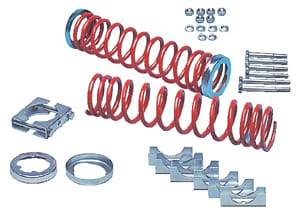...
lmarcrum wrote:
I have a 06 E150 conversion van. I tow a Jayco 27BH. When the camper is loaded and ready to go the weight of the camper makes the van suspension set low. I was wondering if an air suspension kit might elevate this problem. If so any recommendations of suspension kits would be appreciated? With 77,000 miles on the van should I need to make any other modifications to the suspension? Any input would be great!!! Thank you.
Larry,
You may already know most of this.
I second what APT (above) has told you. In other words, by measuring from the ground up to the fender lip, the WD should be adjusted so that the front axle ends up with the same height as when no trailer is hitched. Usually the front naturally lifts a bit when the trailer is 1st hooked up, and adjusting WD to bring the front back down also lifts the rear sag up a bit. The rear will still end up lower than empty but it can't be helped. The front should end up exactly the same height, and this fact* is according to Fords latest recommendations.
EDIT:
*See post below for newer (2013) Ford recommendations.
Since you have a conversion van, there might be quite a bit of load capacity already taken up, making the rear springs sag that much quicker. It depends on how much mass the conversion company added. I think they seldom beef up the suspension, so you may have to do that yourself. The most important thing is that the tires you have,
must be rated high enough to carry your ready-to-go weight.
If you have
P (passenger) rated tires on the van now, you may have to go to
LT (light truck) rated tires. Look at your tire sidewall. If the tire number starts with P, they are passenger tires etc. The
TireRack.com website is one place you can go to find the original tires listed, as well as heavier duty LT tires that are rated to safely carry more weight. Even if you buy tires locally, you will know a lot more about what you want when you visit a local tire dealer.
If cost is a factor in beefing the suspension, I've found the use of these under-$40 type overload springs to be useful.
Superior RideEFFEX™ - Load Control Springs
They are simply designed and fitted, but if they can be applied, they provide some extra load capacity. They merely fit over the shock absorbers similar to expensive coil-over units.
I found them at
O'Reilly's, but the they can also be found on Amazon. Different sets offer either 750 or 1250 pounds of extra capacity. Buying locally helps make sure of fit, if they have them in stock. My guess is that they don't have them in stock because they are not a money maker, but it still easier to return them if necessary. Some HD shocks are thicker-bodied than others.
The springs are intended to be simply sandwiched between two clamps on the shock absorber. Most shock absorbers have an internal oil reservoir next to their outer tubing, but some Monotube designs, such as Bilstein, have a piston contacting directly inside the outer tube. Since the tight clamp tends to slightly distort the outer shock housing, they will not work unless this problem avoided by fabricating different mounting. Those type shocks with reservoirs directly under the shock body, work amazingly well with the simple clamps. The clamps are similar to muffler pipe clamps and dig in by design.
There are several other types of low cost overload springs shown on the O'Reilly page that may also work. New HD shocks aren't a bad idea so they can control the higher spring return rates you might install. In the end, paying more for custom fit high quality air bags may be a better choice, if budget permits. But, remember, paying more doesn't always guarantee a better product. Springs are a very basic machine, especially in metal.
Wes
...
